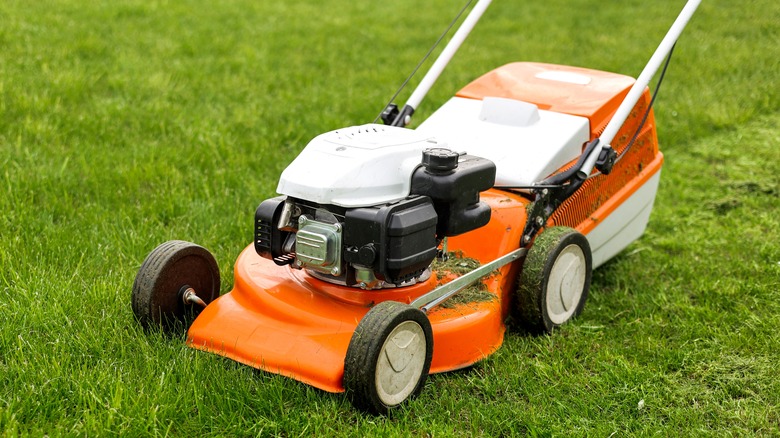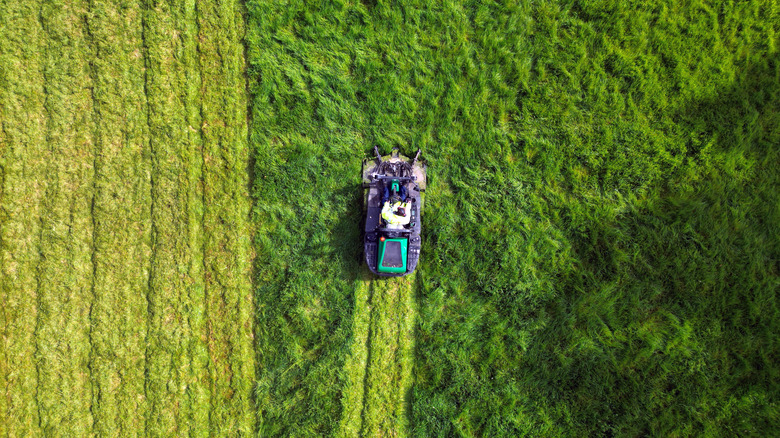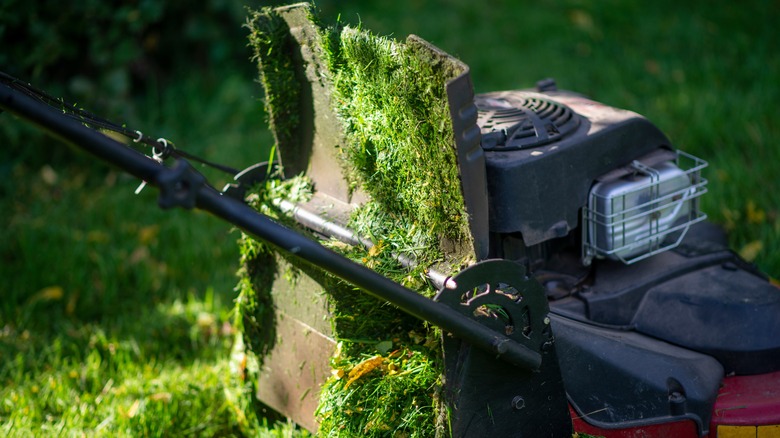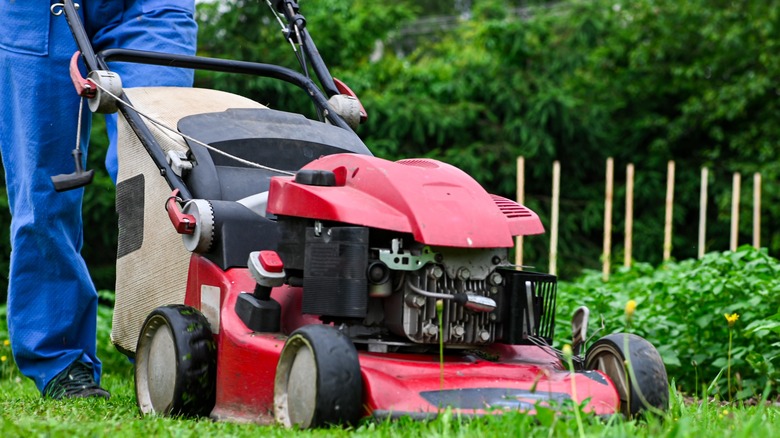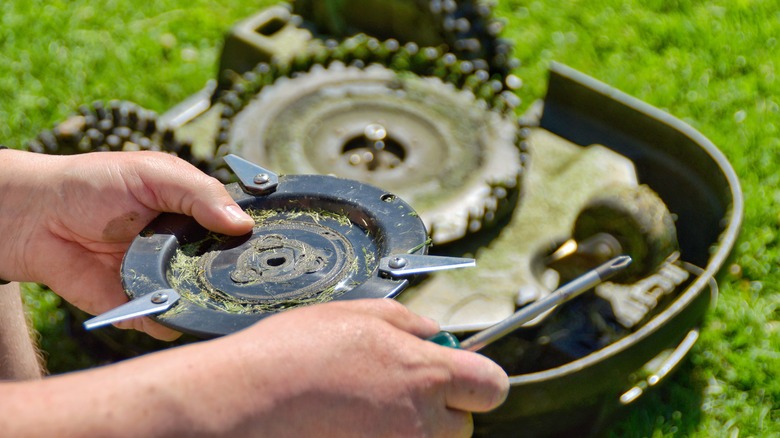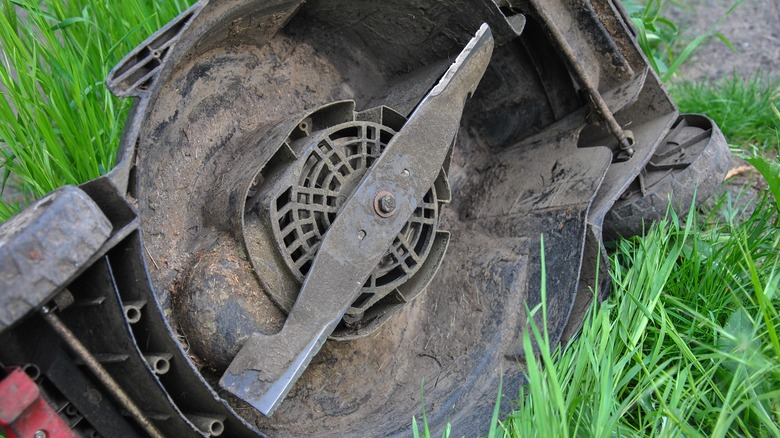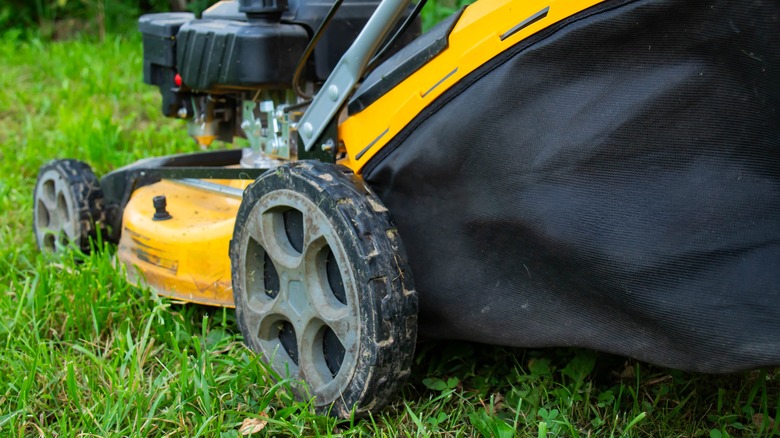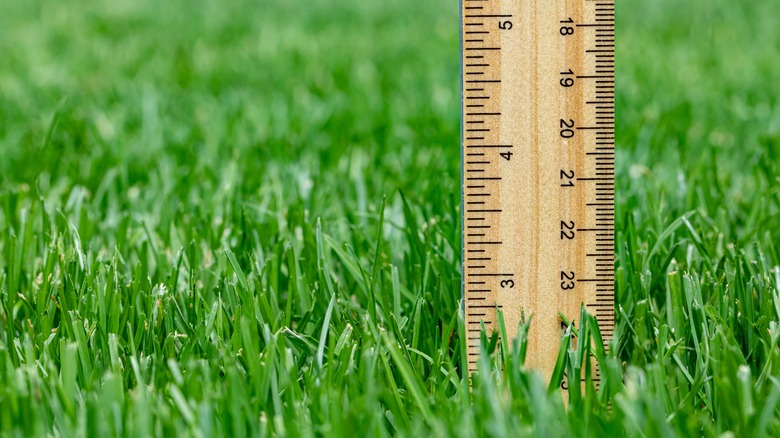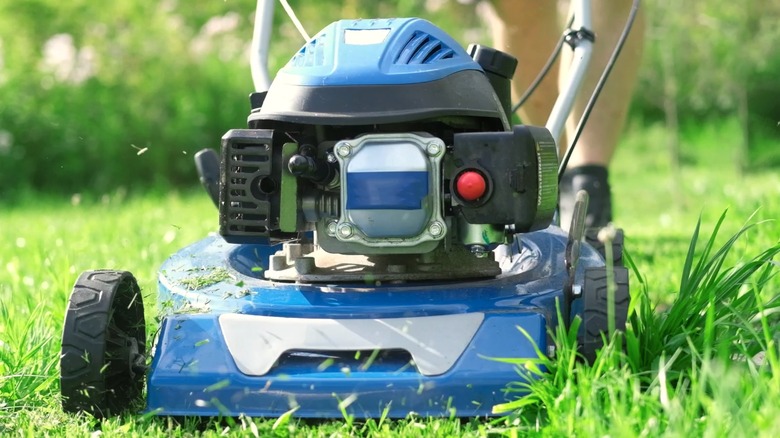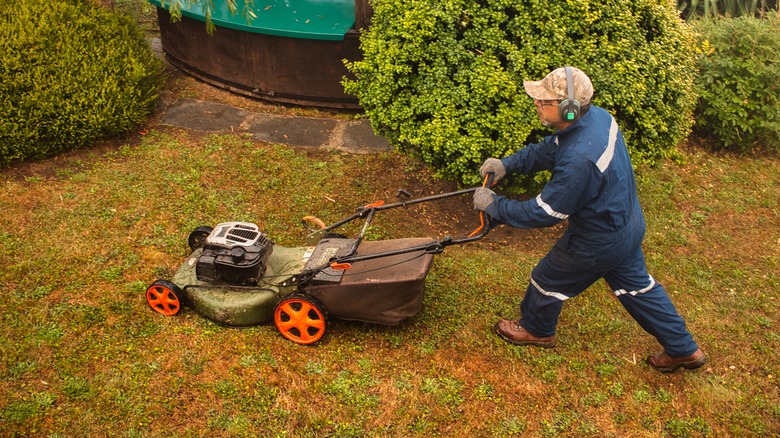Mistakes Everyone Makes With Their Lawn Mower
Mowing the lawn can be one of the more tedious household chores you contend with. Depending on the size of your yard, you could easily spend over an hour going over every inch of grass. It's such cumbersome work that it's no wonder many people are turning to robot lawn mowers despite their often exorbitant cost.
It's a tough job, but someone has to do it. The alternative is allowing your lawn to grow wildly out of control, dooming yourself to being the talk of the block for the worst reasons. Even if you don't care what people say, there's still the matter of weeds popping up, which are even more of a pest to deal with than simply cutting grass.
Rather than incur the wrath of any potential HOAs, your best bet is to cut your lawn regularly; however, there's more to this chore than meets the eye. To achieve the most perfect yard imaginable, you'll need to avoid some common pitfalls. There are numerous lawn mower mistakes that'll make your grass look uneven or even damage your lawn mower. Even a non-robot variety isn't cheap to replace, so keep an eye out for these errors you may already be making.
Mowing infrequently
For most yards, mowing should ideally take place once a week. This is enough to keep the grass a good length and adequately dense enough to prevent weeds from sprouting. Weed seeds can arrive from a number of sources, typically from the wind blowing them to your property. When the grass is long enough, seeds can't reach the soil, so the weeds never take hold.
It's possible you can go a little longer without mowing during summer. When it's dryer outside, the grass may not grow as fast, so you could probably get away with mowing once every two weeks. Proper frequency also comes down to what type of mower you own. The two most common varieties are rotary and cylinder mowers, with rotary mowers using a spinning blade to cut grass while cylinder ones have a barrel-shaped blade, which can offer a more manicured aesthetic. Both are perfectly fine, but if you have a cylinder mower, you might still need to cut your grass at least once a week during summer.
Over time, you'll find a timeframe that works for your to maintain lawn. Above all else, you want to follow the one-third rule, which means never cutting more than a third of a blade of grass during any individual mowing session. Going beyond that will place far too much stress on your yard, which can impact its aesthetic and overall health. For this reason, it's vital to learn how to adjust the cutting height of your push mower, especially if it's new.
Mowing in one direction
It's easy to fall into patterns with any chore. You probably scrub dishes and fold clothes with the same patterns week-to-week, and while there's nothing wrong with doing that, you need to mix things up when it comes to mowing your lawn.
Grass may seem simple, but it acclimates to its environment. If you push a lawn mower over it in the same direction every single time, then it's going to learn to grow in that direction. This isn't going to look right from a distance, and there's bound to be some unevenness. Since it's not growing in straight, grass blades won't get sunlight and nutrients from all sides, which could lead to it changing color and dying.
Another issue with always mowing in the same direction is the risk of soil compaction, especially if you mow when the soil is soggy. This causes the soil to get packed in too tightly, making it more difficulty for water to reach your yard's roots. Switching up your routine increases the chances of grass growing in straight, making it look better and healthier.
Mowing when the grass is wet
You may be all ready to mow your yard, only for it to rain the night before. Even if you're trying to stick to a schedule, it's best to wait to cut the grass until it's all dry again, as numerous issues can materialize if you attempt to mow a wet lawn.
Wet grass is far more difficult to cut. It's slicker, so the blade may not adequately cut each blade the same height. At the end of the day, you'll wind up with an uneven lawn, at best. That's nothing to say of the damage your lawn mower can sustain, as moisture from the soil and grass can wreak havoc on the engine and fuel tank of older gas-powered mowers. It can corrode various other parts, requiring replacements far sooner than you anticipated.
Electric mowers don't fare much better than gas powered units in this regard. When moisture comes into contact with an exposed wire you could shock yourself and your mower might end up damaged. That's to say nothing of the injuries you can sustain when trying to mow after some rain. You could end up slipping and falling over, so you're better off letting your grass get a little tall and dealing with it later.
Mowing too quickly
Perhaps you like taking time out of your day to manicure your yard. There's nothing wrong with taking pride in your work, but you'd probably still prefer to rest on the couch to relax with a good book or watch a football game. It's easy to want to mow as quickly as possible, but that could bite you later if you're not careful, especially if you have a freshly clean and sharp blade in your machine.
The optimal speed for most rotary mowers will be between three and five miles per hour. That means your basic walking speed should be just fine. Trying to push your lawn mower to its limits may get you in trouble, as the mower could easily skip over large patches of grass blades, resulting in an uneven appearance. Even worse, going too fast could cause the mower to rip chunks of grass out by the root, leaving unsightly divots.
Anyone who wants to make mowing the lawn a bit easier on themselves may want to look into a self-propelled lawn mower, which is worth buying as you can adjust its speed so that you don't have to push as much. For large lawns, riding mowers also come in handy, which can reach speeds of up to six miles per hour without damaging the grass.
Neglecting maintenance
It's generally recommended to perform a thorough inspection of your lawn mower and complete basic maintenance tasks at least once a year. However, you may want to consider doing it more often, especially if you use it regularly.
The most crucial component to look at is the blade. Make sure you follow all safety procedures, such as wearing gloves when handling sharp objects. You can usually use a putty knife or a brush to remove any debris from the blade so that it can continue cutting grass perfectly. One handy hack is to spray your lawn mower blade with WD-40 because it removes any debris and also prevents grass from sticking to it for the immediate future, meaning it won't get gunked up again anytime soon.
Anyone with a gas-powered mower will need to clean the air filter for every 25 hours of use. It's also a good idea to frequently wash the underside of your mower's deck to get rid of any lingering grass clippings so that they don't impede its function. While it's fine to use water to wash your mower, give it enough time to air dry before using it again.
Mowing with a dull blade
Your lawn mower blade regularly takes a beating, and over time it's not going to be resilient enough to adequately cut grass. First off, you should be aware of when it's probably best simply to replace the blade, as most should be swapped out once every two years. You'll also want to get a new one if it's bent or otherwise damaged. However, if it's just a little dull then there are some tricks you can use to get it sharp again.
There are plenty of tools you can use to sharpen a lawn mower blade. An angle or bench grinder can get the job done, provided you wear the necessary safety gear like goggles and handle the blade carefully. Many hardware stores also sell dedicated lawn mower blade sharpeners that are specifically designed for such items.
A dull blade either won't cut grass or it may take out more than you intended since it can't seamlessly slice through it. It's a good idea to sharpen your blade after 25 hours of use, and for the most part, you only really want to sharpen a dull blade twice before just looking for a replacement. Blades do slightly weaken after sharpening, so after a couple of times, it may not do much good.
Mowing with deflated tires
A lot of attention has been given to lawn mower blades, but you also want to keep an eye on the tires in case there's any degradation. This is mostly pertinent to riding mowers since they have larger tires with more air, but it's good to bear in mind for any type of mower. These tires are susceptible to various forms of damage, as there's an inherent risk of pushing a mower over a thorn or other sharp item that could damage it. The rubber becomes weaker over time when frequently exposed to sunlight, increasing the chances of cracking.
You can easily tell if your tires are starting to weaken because it'll feel wobbly on one side. It's possible you'll even notice the grass being uneven, as one side of the mower will be lower than the other. You may even feel the mower begin to slip even when it's not wet outside if one or more tires have lost significant tread, preventing it from gripping the soil well enough to move properly when you push.
In the event a tire is a little low on air, it's easy enough to refill it. When it comes time for a full replacement, you'll want to stick with the exact manufacturer specifications of your lawn mower so that the size and tread are suitable enough for your lawn. Additionally, make sure to store your lawn mower in a garage or shed where it's not constantly exposed to sunlight so that the tires remain viable for longer.
Mowing the lawn too short
The often-repeated one-third rule states that you should only ever remove one-third of a blade of grass at a time. Even then, it's good to keep an eye on how long your grass has grown because you never want to over-cut it, as tempting as it may be to go a little short so that you can go a few weeks between each mow.
A good rule of thumb is to ensure grass blades remain between two and two-and-a-half inches in height. You want grass blades to stay at least a little long because when there's more surface area there's more room for the grass to absorb sunlight. More sunlight leads to stronger roots, resulting in a healthier yard overall. If grass blades are only an inch high, it can't photosynthesize as much, leading to a weaker look.
To compensate for shorter grass, you may have to spend more on your water bill. The shorter blades make it easier for sunlight to reach the soil directly, leading to more evaporation. That means less water makes it to the roots. You'll need to water your grass more frequently to make up for this.
Using the wrong lawn mower
We've already gone through the various types of lawn mowers out there. You can have a rotary or cylindrical blade, and there's also the matter of picking between a push or a self-propelled mower. There are pros and cons to all these varieties, so it's really just a matter of what works best for you and what type of yard you have.
For example, push mowers tend to be less expensive and easier to maneuver around tight corners, but you have to exert more pressure to get it moving. Self-propelled mowers do a lot of the pushing for you, but because of that, they can cost a lot more. They also tend to be heavier, which makes it more difficult to operate them efficiently.
There's also the matter between gas-powered and electric mowers. Gas is worse for the environment, but you need to make sure you charge electric mowers with enough notice so that it doesn't run out of juice halfway through the job. That's not even getting into a good, old-fashioned reel mower with no electrical components whatsoever. There's no one-size-fits-all solution, so consider how much grass you have to maintain and how much energy you're willing to expend on a weekly basis.
Not adjusting for changing seasons
Keeping grass blades around roughly two inches is a general rule to adhere to. If you genuinely want the best-looking lawn on the block, it's best to adjust throughout the year according to the specific grass you have and what the weather's like at the moment. First, it's important to learn about the different types of grass, namely cool season and warm season grass. Naturally, the cool variety is what you find in colder climates and encompasses creeping bentgrass and Kentucky bluegrass. Conversely, warm season grasses are in warmer climates or more desert-like areas and include zoysiagrass and bermudagrass.
When it's fall and starts getting colder out, you want to keep cool season grass at two-and-a-half inches maximum while warm season should only be about two inches. In the summer, you could keep cool season grass up to four inches, but the other kind should still stay between that two to two-and-a-half inch threshold. By the time winter rolls around, you'll probably stop cutting your grass for a while. You'll want to cut your grass a little shorter than usual before the first frost of the season, and then it's probably a good idea to put the mower away for a while since you don't want to mow grass that's gotten wet from snow.
It's good to take pride in your lawn's look. No one wants to be that one funky-looking house on the street, and by avoiding some common lawn mower mistakes, your lawn can be a positive reflection of your hard work and dedication.
